check engine Alfa Romeo 8C 2010 Owner handbook (in English)
[x] Cancel search | Manufacturer: ALFA ROMEO, Model Year: 2010, Model line: 8C, Model: Alfa Romeo 8C 2010Pages: 223, PDF Size: 14.35 MB
Page 150 of 223

148
6
CD
E
F
Remove the cigarette lighter
C, and insert the
connector
D.
Start the engine by pressing the start button (see
page 114).
Press the Fix&Go button
E at position “I”. The
electric compressor will activate and the liquid
with air will inflate the tyre.
A pressure of at least 1.8 bar (26 psi) should
be reached within 20 minutes. If this does not
occur, turn off and remove the Fix&Go kit.
Move the vehicle forward and backward by 10
metres to better distribute the sealant in the tyre.Attach the quick-connector of the compressor
directly on the tyre valve and repeat the inflation
procedure.
If the minimum tyre pressure is not reached,
do not start the vehicle. Contact an Authorised
Service Centre of the Manufacturer’s
Network.
When the correct pressure has been reached,
move the vehicle forward and backward to
evenly distribute the sealant in the tyre.
After 10 minutes, stop and check the tyre
pressure. If the pressure is below 1.3 bar
(19 psi), do not drive the vehicle. The tyre is
excessively damaged. Contact an Authorised Service Centre of the
Manufacturer’s Network.
If the pressure is equal to or greater than 1.3
bar (19 psi), repeat the inflation procedure until
reaching the adequate tyre pressure and resume
driving.
Remove the warning label
F from the bottle and
position it on the dashboard as a reminder to
the driver that the tyre has been treated with
automatic Fix&Go.
Page 170 of 223

168
6
B
C
A
IF THE BATTERY IS
FLAT First of all, we recommend that you read
the precautions contained in the section
”Maintenance“ to prevent the battery from
running flat and to help ensure its long life.
STARTING WITH THE
AUXILIARY BATTERY
See the chapter ”Starting the engine“ on page
114 in the section ”Using the vehicle”.WARNING: Under no circumstance should a
battery be used for an emergency start-up: This
could damage the electronic systems, particularly
the control units managing the ignition and fuel
supply functions.
RECHARGING THE
BATTERY
You are advised to recharge the battery slowly
and at a low amperage for about 24 hours.
Proceed as follows:
1) Deactivate the electronic alarm using the
radio control.
2) Lift the rear shelf
A and the box cover
B
and release the hooks
C.
WARNING: First disconnect the negative pole
terminal (–) then the positive pole one (+).3) Connect the battery charger cables to the
battery poles.WARNING: The battery is housed in a metal box, therefore, be extremely careful not to let the
battery charger clips come into contact with it.
4) Turn on the battery charger.
5) When the battery is recharged, turn off the
battery charger before disconnecting it from
the battery.
6) Reconnect the terminals to the battery
poles, observing the polarity.WARNING: First reconnect the positive pole
terminal (+) and then the negative pole one
(–).
WARNING: Before reconnecting the battery
terminals, check that the key has been removed
from the ignition or at least that it is in the STOP
position.
Page 178 of 223
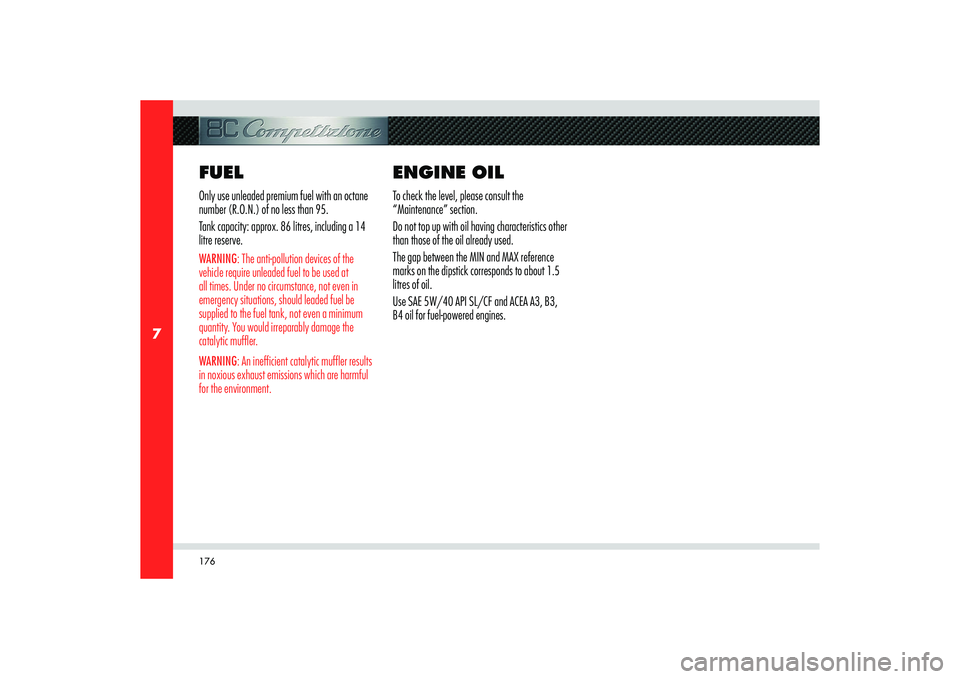
176
7
FUELOnly use unleaded premium fuel with an octane
number (R.O.N.) of no less than 95.
Tank capacity: approx. 86 litres, including a 14
litre reserve.WARNING: The anti-pollution devices of the
vehicle require unleaded fuel to be used at
all times. Under no circumstance, not even in
emergency situations, should leaded fuel be
supplied to the fuel tank, not even a minimum
quantity. You would irreparably damage the
catalytic muffler.
WARNING: An inefficient catalytic muffler results
in noxious exhaust emissions which are harmful
for the environment.
ENGINE OILTo check the level, please consult the
“Maintenance” section.
Do not top up with oil having characteristics other
than those of the oil already used.
The gap between the MIN and MAX reference
marks on the dipstick corresponds to about 1.5
litres of oil.
Use SAE 5W/40 API SL/CF and ACEA A3, B3,
B4 oil for fuel-powered engines.
Page 194 of 223
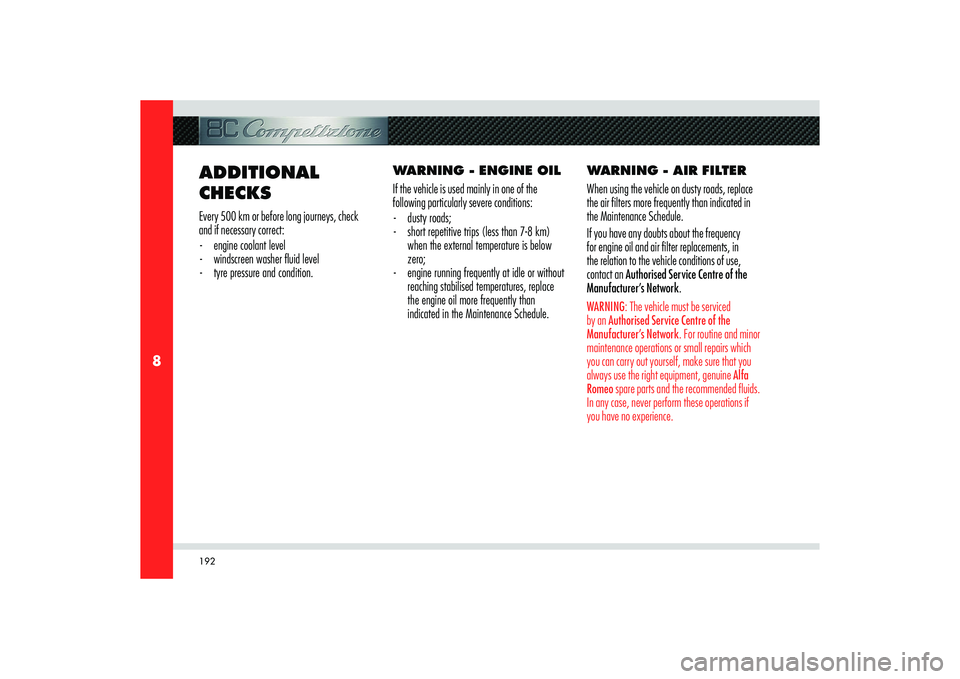
192
8
ADDITIONAL
CHECKSEvery 500 km or before long journeys, check
and if necessary correct:
- engine coolant level
- windscreen washer fl uid level
- tyre pressure and condition.WARNING - ENGINE OIL
If the vehicle is used mainly in one of the
following particularly severe conditions:
- dusty roads;
- short repetitive trips (less than 7-8 km)
when the external temperature is below
zero;
- engine running frequently at idle or without
reaching stabilised temperatures, replace
the engine oil more frequently than
indicated in the Maintenance Schedule. WARNING - AIR FILTER
When using the vehicle on dusty roads, replace
the air filters more frequently than indicated in
the Maintenance Schedule.
If you have any doubts about the frequency
for engine oil and air filter replacements, in
the relation to the vehicle conditions of use,
contact an Authorised Service Centre of the
Manufacturer’s Network.
WARNING: The vehicle must be serviced
by an Authorised Service Centre of the
Manufacturer’s Network. For routine and minor
maintenance operations or small repairs which
you can carry out yourself, make sure that you
always use the right equipment, genuine Alfa
Romeo spare parts and the recommended fluids.
In any case, never perform these operations if
you have no experience.
Page 195 of 223
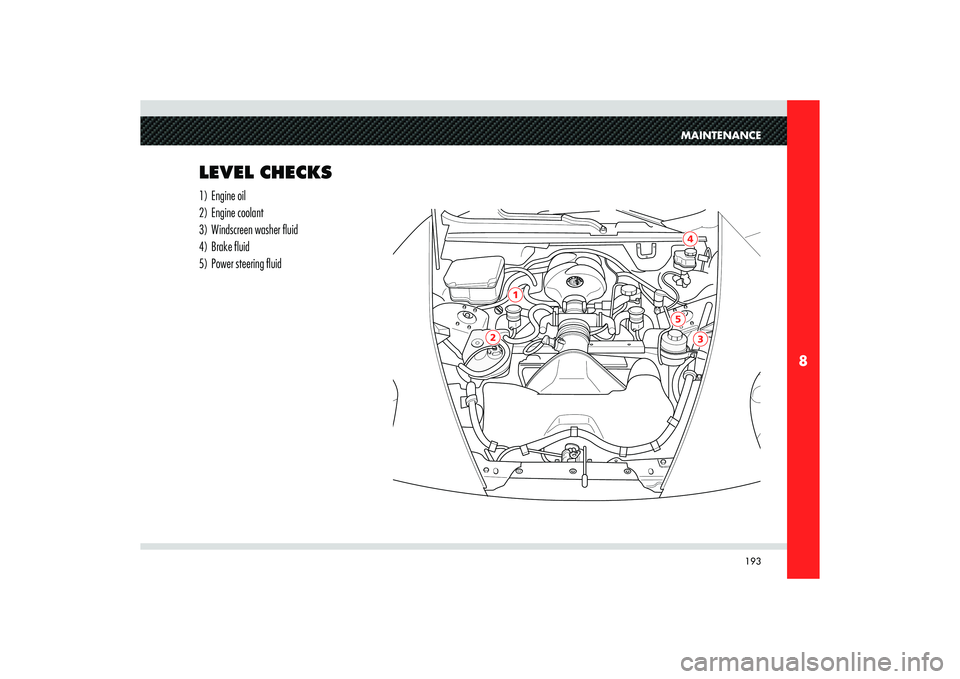
193
8
2
5
3
1
4MAINTENANCE
LEVEL CHECKS1) Engine oil
2) Engine coolant
3) Windscreen washer fluid
4) Brake fluid
5) Power steering fluid
Page 196 of 223
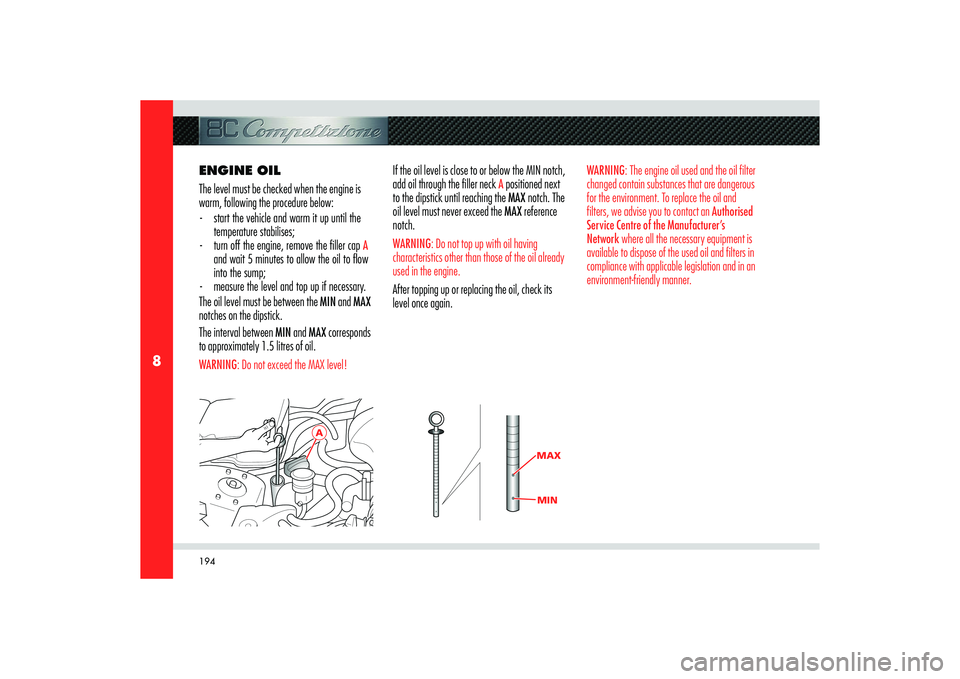
194
8
A
MAXMIN
ENGINE OIL
The level must be checked when the engine is
warm, following the procedure below:
- start the vehicle and warm it up until the
temperature stabilises;
- turn off the engine, remove the fi ller cap
A
and wait 5 minutes to allow the oil to fl ow
into the sump;
- measure the level and top up if necessary.
The oil level must be between the MIN and MAX
notches on the dipstick.
The interval between MIN and MAX corresponds
to approximately 1.5 litres of oil.
WARNING: Do not exceed the MAX level!
If the oil level is close to or below the MIN notch,
add oil through the filler neck
A positioned next
to the dipstick until reaching the MAX notch. The
oil level must never exceed the MAX reference
notch.
WARNING: Do not top up with oil having
characteristics other than those of the oil already
used in the engine.After topping up or replacing the oil, check its
level once again.
WARNING: The engine oil used and the oil filter
changed contain substances that are dangerous
for the environment. To replace the oil and
filters, we advise you to contact an Authorised
Service Centre of the Manufacturer’s
Network where all the necessary equipment is
available to dispose of the used oil and filters in
compliance with applicable legislation and in an
environment-friendly manner.
Page 197 of 223
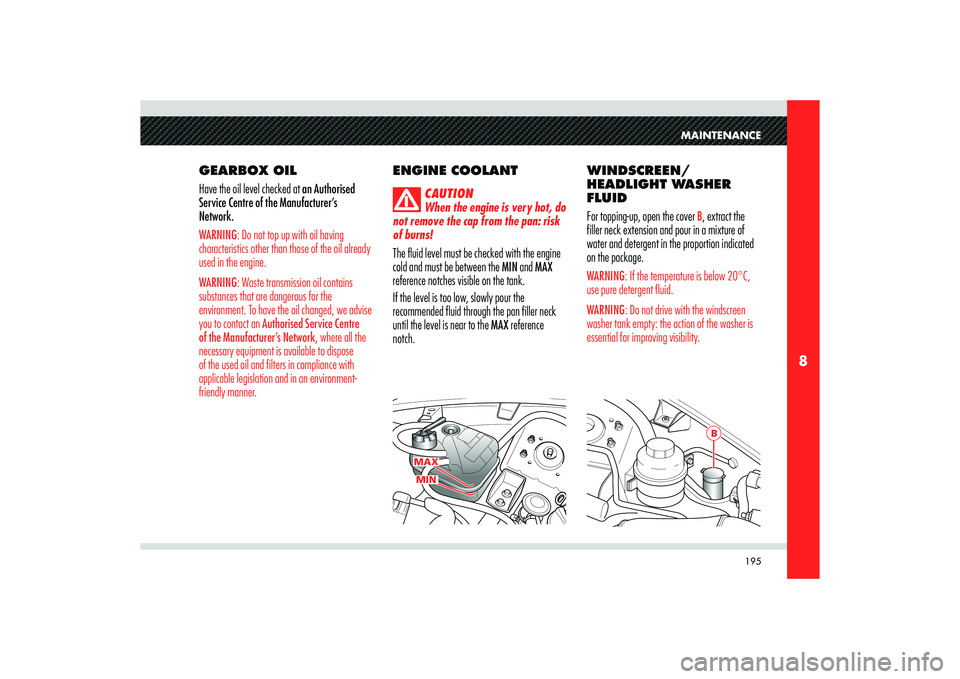
195
8
MAXMIN
B
MAINTENANCE
GEARBOX OIL
Have the oil level checked at an Authorised
Service Centre of the Manufacturer’s
Network.WARNING: Do not top up with oil having
characteristics other than those of the oil already
used in the engine.
WARNING: Waste transmission oil contains
substances that are dangerous for the
environment. To have the oil changed, we advise
you to contact an Authorised Service Centre
of the Manufacturer’s Network, where all the
necessary equipment is available to dispose
of the used oil and filters in compliance with
applicable legislation and in an environment-
friendly manner.
ENGINE COOLANT
CAUTION
When the engine is very hot, do
not remove the cap from the pan: risk
of burns!
The fluid level must be checked with the engine
cold and must be between the MIN and MAX
reference notches visible on the tank.
If the level is too low, slowly pour the
recommended fluid through the pan filler neck
until the level is near to the MAX reference
notch.WINDSCREEN/
HEADLIGHT WASHER
FLUID
For topping-up, open the cover
B, extract the
filler neck extension and pour in a mixture of
water and detergent in the proportion indicated
on the package.
WARNING: If the temperature is below 20°C,
use pure detergent fluid.
WARNING: Do not drive with the windscreen
washer tank empty: the action of the washer is
essential for improving visibility.
Page 198 of 223
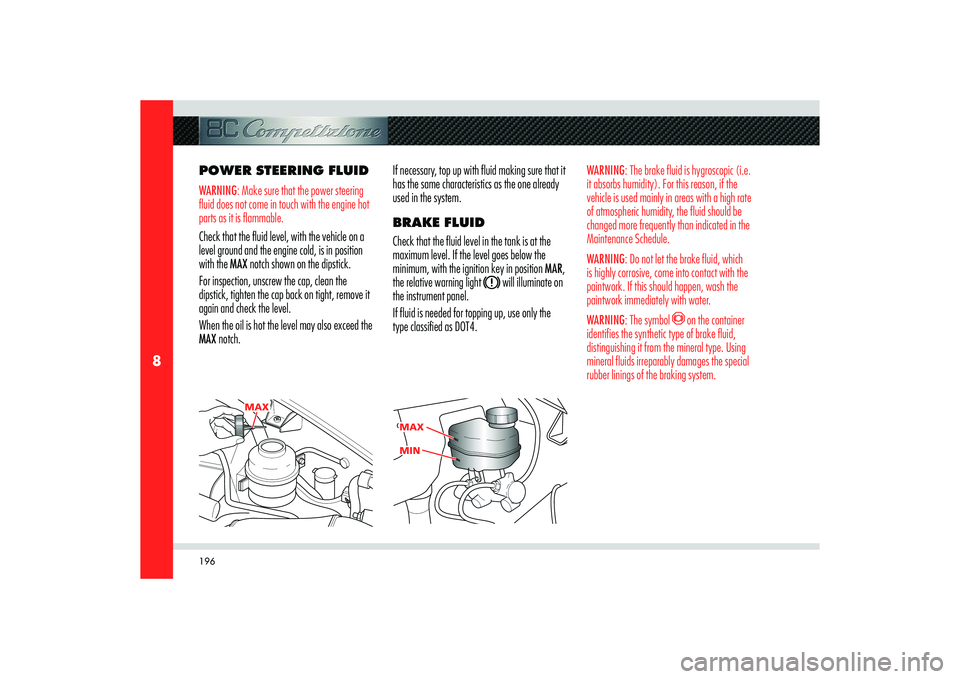
196
8
MAX
MA
X MAX
MIN MIN
POWER STEERING FLUIDWARNING: Make sure that the power steering
fluid does not come in touch with the engine hot
parts as it is flammable.Check that the fluid level, with the vehicle on a
level ground and the engine cold, is in position
with the MAX notch shown on the dipstick.
For inspection, unscrew the cap, clean the
dipstick, tighten the cap back on tight, remove it
again and check the level.
When the oil is hot the level may also exceed the
MAX notch.If necessary, top up with fluid making sure that it
has the same characteristics as the one already
used in the system.
BRAKE FLUID
Check that the fluid level in the tank is at the
maximum level. If the level goes below the
minimum, with the ignition key in position MAR,
the relative warning light
will illuminate on
the instrument panel.
If fluid is needed for topping up, use only the
type classified as DOT4.
WARNING: The brake fluid is hygroscopic (i.e.
it absorbs humidity). For this reason, if the
vehicle is used mainly in areas with a high rate
of atmospheric humidity, the fluid should be
changed more frequently than indicated in the
Maintenance Schedule.
WARNING: Do not let the brake fluid, which
is highly corrosive, come into contact with the
paintwork. If this should happen, wash the
paintwork immediately with water.
WARNING: The symbol
on the container
identifies the synthetic type of brake fluid,
distinguishing it from the mineral type. Using
mineral fluids irreparably damages the special
rubber linings of the braking system.
Page 200 of 223

198
8
A
B
C
BATTERYThe battery is of the “low maintenance” type,
and is located on the right side of the luggage
compartment
To access the battery lift the shelf and
A and the
box cover
B releasing the hooks.
C.
With the vehicle standing on a flat surface, the
battery fluid level (electrolyte) must be between
the MIN and MAX reference notches shown on
the battery.
If the level is lower than the MIN reference
notch, contact an Authorised Service Centre
of the Manufacturer’s Network to have it
checked.To recharge the battery, see the section “In an
emergency”.
CAUTION
The fluid contained in the
battery is poisonous and corrosive.
Avoid contact with the skin and eyes.
Do not approach the battery with open
flames or possible sources of sparks:
risk of explosion and fire!
Batteries contain substances that are very
harmful for the environment. We advise you
to have the battery replaced at an Authorised
Service Centre of the Manufacturer’s
Network, where all the necessary equipment
is available to dispose of the used parts in compliance with applicable legislation and in an
environment-friendly manner.
WARNING: Incorrect assembly of electrical and
electronic accessories can cause serious damage
to the vehicle.USEFUL HINTS FOR
EXTENDING THE LIFE OF
THE BATTERY
When parking the vehicle, make sure that the
doors, luggage and engine compartment lids
are properly closed. All interior lights should be
off. When the engine is off, do not keep the
connected devices switched on for a long time
(for example the radio, the hazard warning
lights, the fan, etc.).
Page 201 of 223

199
8
MAINTENANCE
WARNING: If the battery charge remains
below 50% for a long period of time, it will be
damaged due to sulphating: this will reduce its
performance and starting power and the battery
will be more subject to freezing (this can happen
even at -10°C).We recommend that you have the battery charge
condition checked, preferably at the beginning of
the cold season, to prevent the electrolyte from
freezing.
This check should be performed more frequently
if the vehicle is used mainly for short trips or if it
is equipped with power absorbing devices that
remain permanently on even if when the ignition
key is removed. This applies above all if these
devices have been fitted “after market”.
If the vehicle is not used for long periods of time,
please refer to chapter “If the vehicle is laid up
for long periods”, in this section.WARNING: If additional systems have to be
fitted in the vehicle, there is the risk of creating
dangerous branches on the electric wiring, in
particular if the safety devices are involved.
ELECTRONIC
CONTROL UNITSNo special precautions are required for the
normal use of the vehicle.
In the event of repairs to the electrical system
or in an emergency starting, the following
instructions must be strictly followed:
- Never disconnect the battery from the
electrical system when the engine is
running.
- Disconnect the battery from the electrical
system when recharging it (see page 168
“If the battery is fl at”). WARNING: When the battery is disconnected,
you must first detach the negative pole terminal
(–) and then the positive pole one (+).
WARNING: The battery is secured inside the
vehicle by means of a metal box, therefore, be
extremely careful not to let the battery charger
clips come into contact with it.WARNING: When the battery is reconnected,
you must first attach the positive pole (+),
remembering to cover it with the cap provided,
and then the negative one (–).
- Never perform the emergency starting
procedure using a battery charger: always
use an auxiliary battery.
- Take special care when connecting the
battery to the electrical system, checking
both that polarity is correct and that the
connection is properly working.
- Do not connect or disconnect the terminals
of the ECUs when the ignition key is at
MAR.
- Do not check the electric polarities through
sparking.
- Disconnect the ECUs in the event of
electrical welding on the vehicle body.
Remove them if the temperature is
over 80°C (special interventions on the
bodywork, etc.).